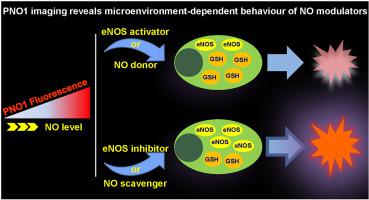Journal of Pharmaceutical Analysis ( IF 6.1 ) Pub Date : 2020-06-06 , DOI: 10.1016/j.jpha.2020.05.010 Ying Dong , Xiao-Rong Li , Jia Li , Yi Zang , Xin Li

|
Nitric oxide (NO) is a second messenger playing crucial roles in the signaling of a variety of cellular functions. Due to its pathophysiological significance, various NO modulators have been developed to explore NO pathways and some have been used as therapies. These modulators are often used directly to observe pharmacological effects in cell lines, but their actual effect on intracellular NO level is seldom analyzed. Herein, facilitated by a selective and sensitive fluorescence probe, we observed that some NO modulators displayed unexpected behaviors with both NO scavenger carboxy-PTIO and endothelial nitric oxide synthase (eNOS) inhibitor N(ω)-nitro-l-arginine methyl ester (l-NAME) failing to decrease intracellular free NO level in EA. hy926 cells while NO donor diethylamine-NONOate (DEA·NONOate) and eNOS activator calcimycin (A23187) failing to increase free NO level in human umbilical vein endothelial cell line (HUV-EC-C), although the reagents were confirmed to work normally in the primary human umbilical vein endothelial cells (primary HUVECs) and RAW 264.7 macrophage cells. Further research suggested that these unusual behaviors might be attributed to the cellular microenvironments including both the NO synthase (NOS) level and the endogenous glutathione (GSH) level. Genetically manipulating eNOS level in both cells restores the expected response, while decreasing GSH level restores the ability of DEA·NONOate to increase NO level in HUV-EC-C. These results reveal that the cellular microenvironment has a profound impact on pharmacological effect. Our study suggests GSH as a reservoir for NO in live cells and highlights the value of chemical probes as valuable tools to reveal microenvironment-dependent pharmacological effects.
中文翻译:

选择性和灵敏的荧光成像显示内皮系统中NO调节剂的微环境依赖性行为
一氧化氮(NO)是第二种信使,在多种细胞功能的信号传递中起着至关重要的作用。由于其病理生理学意义,已经开发了各种NO调节剂来探索NO途径,并且一些已被用作疗法。这些调节剂通常直接用于观察细胞系中的药理作用,但很少分析它们对细胞内NO水平的实际作用。在这里,在选择性和灵敏的荧光探针的辅助下,我们观察到一些NO调节剂与NO清除剂羧基-PTIO和内皮型一氧化氮合酶(eNOS)抑制剂N(ω)-硝基-1-精氨酸甲酯(l-NAME)无法降低EA中的细胞内游离NO水平。hy926细胞,而NO供体二乙胺-壬酸酯(DEA·NONOate)和eNOS活化剂降钙素(A23187)未能增加人脐静脉内皮细胞系(HUV-EC-C)中的游离NO水平,尽管已证实该试剂可在人脐静脉内皮细胞(原HUVEC)和RAW 264.7巨噬细胞。进一步的研究表明,这些异常行为可能归因于细胞微环境,包括NO合酶(NOS)水平和内源性谷胱甘肽(GSH)水平。遗传控制两个细胞中的eNOS水平可恢复预期的反应,而降低GSH水平可恢复DEA·NONOate增加HUV-EC-C中NO水平的能力。这些结果表明细胞微环境对药理作用具有深远的影响。我们的研究建议将GSH用作活细胞中NO的储存库,并强调化学探针作为揭示微环境依赖性药理作用的有价值工具的价值。











































 京公网安备 11010802027423号
京公网安备 11010802027423号